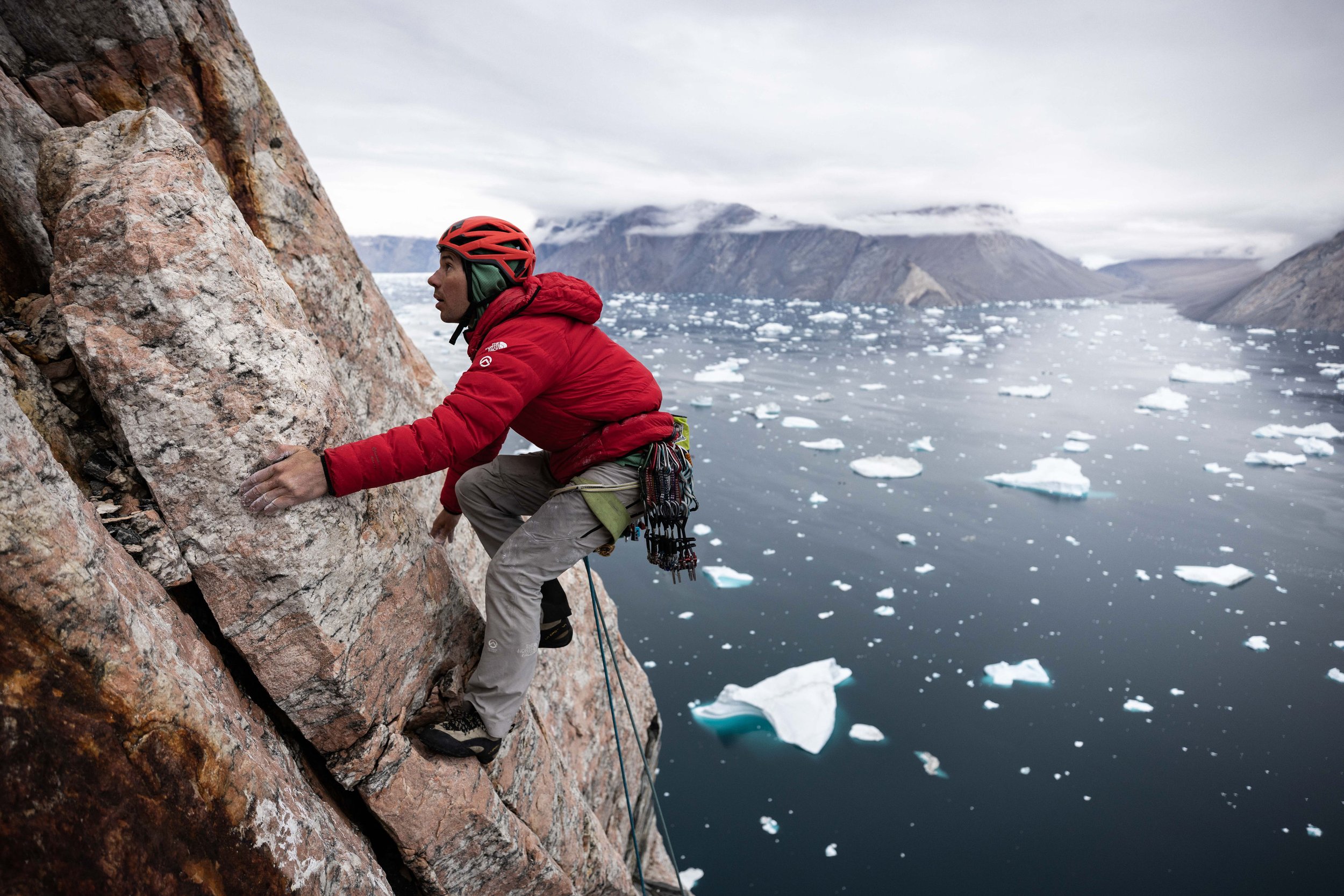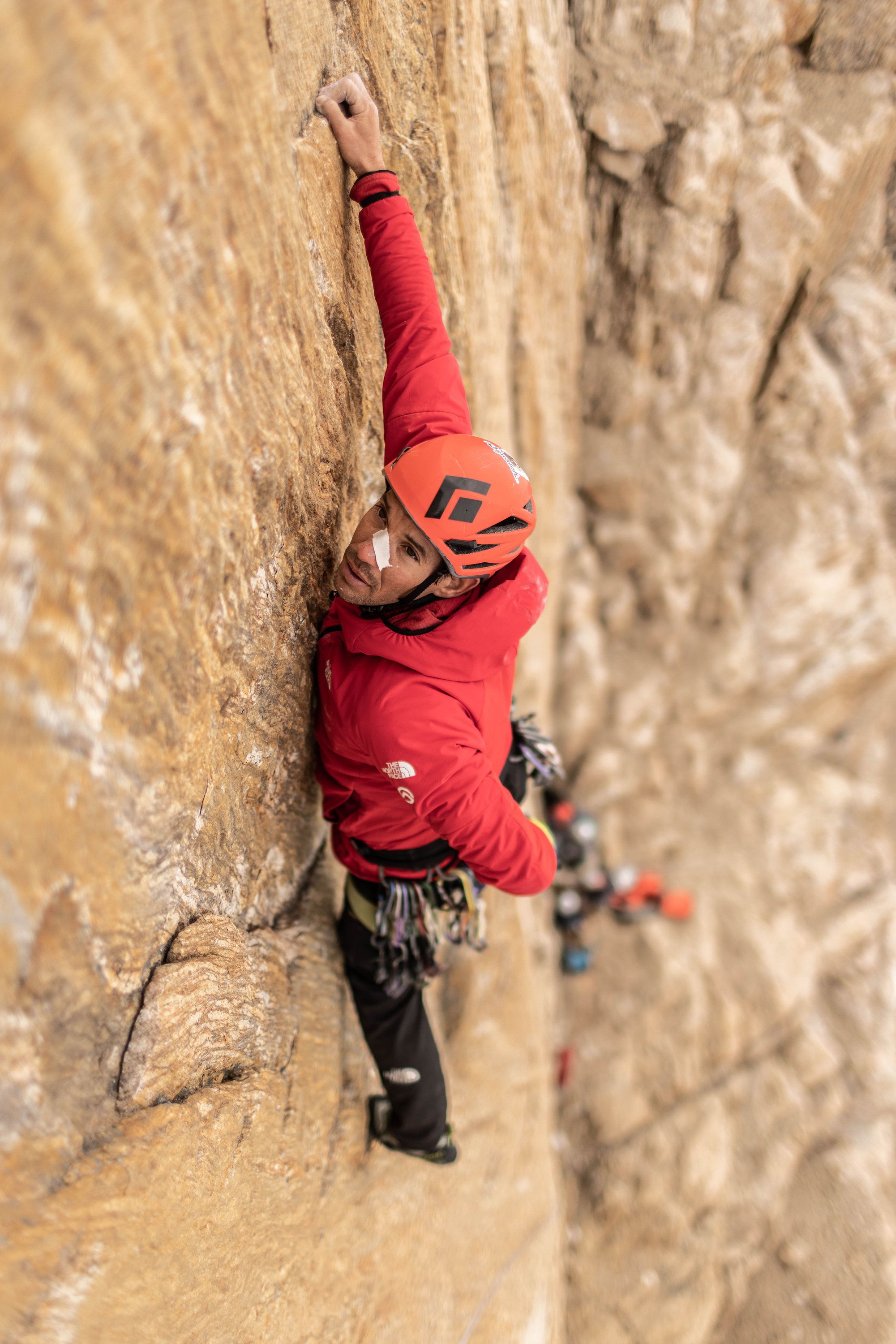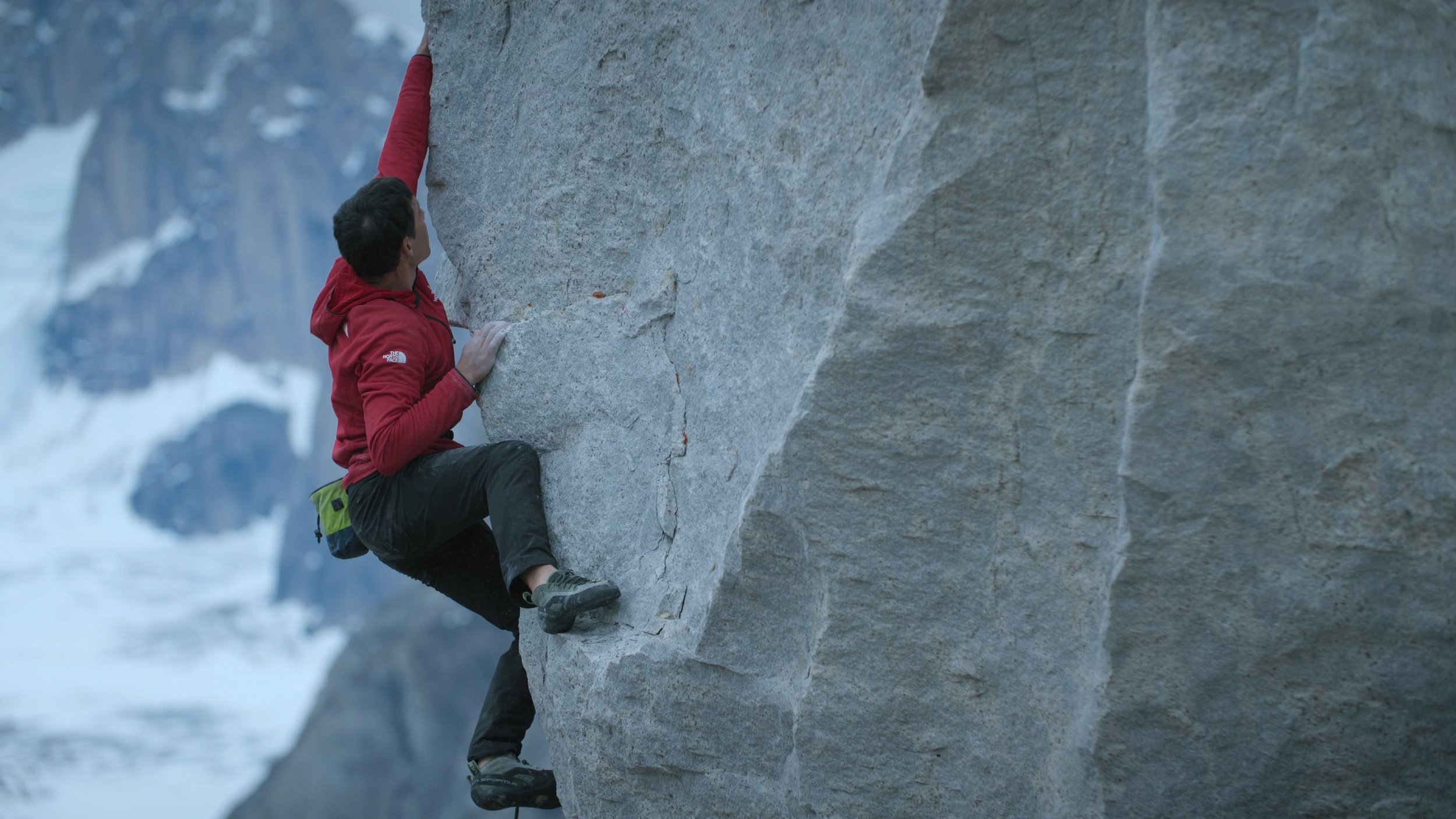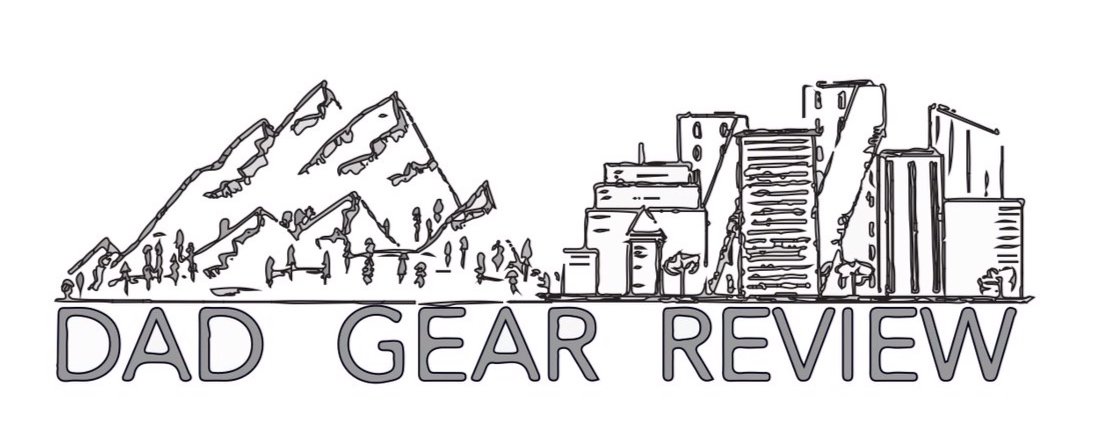
alex honnold talks fatherhood, climbing, climate, and gear
It’s not that often that one gets a chance to talk to a person considered the “best on earth” at anything — when that person happens to be the arguable best at something said person is personally passionate about, the situation becomes even more remarkable. The one in question here was me, the something was climbing, and the best on earth was climber Alex Honnold.
You know, the gentleman that completed the astounding free solo climb up Yosemite’s 3,000 foot granite monolith known as El Capitan? (Yes, a free solo climb means climbing alone and without ropes.) Yes, that climber.
I got the chance to speak to Alex shortly before the premier of his three-part National Geographic show Arctic Ascent with Alex Honnold, which you can (and should) catch on Disney+. But the expedition featured in that show and the climate research conducted by Alex’s team there in Greenland, which included the noted glaciologist Heidi Sevestre, occupied just one portion of our chat.
Alex and I also talked about his early days as a climber, when, in his youth, he hardly considered himself all that good at the sport, about his favorite gear and how to keep your kit simple, and about parenthood and how it changes things so dramatically. At the time of our talk, Alex Honnold and his wife, Sanni, were already parents to a toddler and were expecting their second child in less than two weeks.
Thus, I was even more glad to get a half hour of Alex’s time as, being a father to two kids myself, I knew well that he’d soon be off the map for quite some time, and well deservedly so.
As it happened, our talk began with a focus back on Alex Honnold’s own childhood.
STEVEN JOHN: So, you started climbing at an age when most kids are falling over soccer balls. What got you started?
ALEX HONNOLD: Well, I mean, my parents took me to a gym. Actually I just always loved climbing. I “started” climbing in as much as I went to a climbing gym for the first time, but actually now that I'm a parent, I kind of see it in my own child more; there is a bit of innate desire to just clamor on things and play. And so I kind of always loved playing and getting on top of things and climbing. And then I was just lucky enough that a climbing gym opened near my home, so my parents took me in to check it out.
SJ: When did it become clear that for you climbing was more than a hobby, that it was a calling? When did it become clear that you had a true knack for it?
AH: I don't know. I mean, I think the thing is I've just always loved climbing more than everything else or anything else. So I mean, it's not like I ever chose, I'm going to devote my life to climbing, but day by day, for the last 28 years now, I've just chosen to go climbing rather than do other things. And so I think that becomes your calling, I guess.
SJ: Correct me if I'm wrong, but I remember you saying in the past you didn't consider yourself preternaturally this world-class climber. It's just that you've done it so, so much that you've developed into it. Is that accurate?
AH: Yeah, for sure. I mean, I did youth competitions as a kid and I was good, but I wasn't winning and I wasn't dominant. I wasn't gifted in any way. I think I was into it enough to keep me motivated. The kind of thing where you're good enough that you're like, "Oh, I'm pretty good, so I feel good about it," but not so good that I was actually really good.



SJ: Who have been your idols in the climbing world? Your mentors, and your inspirations in climbing?
AH: Oh, there are many. I mean, people like Peter Croft and John Bachar are like legendary, from the previous generation. I mean mentors, in some way, Conrad Anker. He was the captain of the North Face team for the whole time that I've been an athlete and I've been on a bunch of expeditions with him. And I've definitely learned a lot of just practical things about how to camp on glaciers and how to camp on walls and just how to live in the mountains from Conrad. So I don't know, but mostly I think I've learned from my various partners over the years. It's not so much a mentor, but it's just that the two of you are out there together, learning as you go.
SJ: What are some of the biggest misconceptions people have about climbing?
AH: That it's X-treme with a capital X, I think is maybe the main thing. People see Cliffhanger, the movie, and they think that's rock climbing. The reality couldn't be further from it. It's pretty slow, it's pretty chill, it's really community-focused. You spend most of your time with your friends just out somewhere beautiful, doing something fun. I mean, it's pretty chill.
SJ: Can anyone in decent shape get into climbing or are some people just preternaturally more suited to it?
AH: I think some people probably are more suited to it in the same way that Michael Phelps is probably better suited to being an elite swimmer than being a table tennis champion or something. I mean, body size and shape obviously matters a little bit, but not really as much as people think. And I strongly encourage anybody to try climbing because I think climbing is more forgiving than most sports. It is like anybody can try, anybody can have a good time because you don't have to climb really, really hard. You don't have to climb at an elite level to have a good time. Anybody can have fun climbing.
SJ: What are some of your best tips for people who want to get into it? And what are your tips for people who want to level up?
AH: My tips for people who want to get into it are just to go to a climbing gym and try, because nowadays, there are gyms everywhere in the country, and the bar for entry is super low. You just get your day pass, you get a little instruction if you want it. You don't even need instruction, you just try. You play around, you have a good time. So I think everybody should just try. And then instructions for leveling up, I mean, it totally depends on what level you are on. But my general advice for beginners is to focus on your technique and focus on footwork. Drive with your legs, not your arms. Especially for adults because if you get into the sport later, if you get really strong, it's easier to injure your hands and fingers and things, but if you use good technique and you use your legs, it saves a lot of the strain on the rest of your body.



SJ: Sure. I was bouldering in Joe's Valley a few years ago with a local climber there, and he just gave me this tip that never really occurred to me. He was like: "You're climbing with your hands, you got to be climbing with your legs." And I was like: "Oh, right. Those are bigger muscles.”
AH: Yeah. My tip is that when you climb a staircase, you go up the stairs and you use the handrails for balance; climbing should feel the same way, where it's like, use your legs to drive you up and your hands are for balance.
SJ: Are there any must-have pieces of gear for the novice climber?
AH: Not really. I mean, I think that if you're a real novice, you can just rent everything at the gym. You just go in and just get the stuff when you need it. I mean, the bare essentials are shoes and a chalk bag, basically. I mean, you don't even need a chalk bag, but it is a lot nicer and they only cost like 10 bucks, so you should probably have one. But yeah, shoes and a chalk bag. And then beyond that you get a harness, then maybe eventually a rope. And then if you're really into adventures outdoors, then you have to start acquiring some of the other gear. But for the most part, when you're getting into it, you always should have a friend who's more experienced than you and they'll have the gear you need. And even I went through that process. I mean, for years I climbed on other people's gear until I finally bought my own.
SJ: What are some of your can't live without pieces of gear?
AH: I mean, I have a very specific kit, there is a kit that I always use. I'm always in North Face layers. Basically any layer of jackets will keep you warm outside. I use Sportiva shoes for training indoors. I use Theories for climbing outdoors. I use either Solutions or TC Pros, depending on what I'm climbing. I have a harness and a chalk bag through Black Diamond that are Alex Honnold signature series bags. I use those because part of the proceeds go to the Honnold Foundation, plus they're what I use anyway. It’s a nice harness, and rhe chalk bag is what I used on the Freerider, basically. What I used on El Cap. So yeah, that's shoes, harness, chalk bag, backpack, jacket, and then Black Diamond makes ropes, I just use whatever rope makes sense for the day that I'm doing.
SJ: Beyond climbing, what outdoor gear do you recommend everyone have in their kit? As in should everyone have a good tent, good puffer, good sleeping bag? What are some just general outdoor pieces of gear you think everyone should have?
AH: I would go even more general. I kind of think just a decent pair of shoes and a decent jacket are the main things that people should own because you use them all the time. Like, it's nice to have a good sleeping bag, but it's not really critical, because you could just swaddle yourself in blankets and get through the one night that you're camping. It's not that big a deal, but I think having a good jacket and a good pair of shoes, you'll use all the time is key.
SJ: That's very true. Do you have a pair or a brand of hiking boots or shoes that you swear by?
AH: I use Sportiva Approach shoes all the time. The TX Guides are what I'm using right now. And actually mostly though, just because they climb really, really well and anytime I'm hiking, I wind up doing some amount of climbing. Also, I would say, I think this is maybe under-appreciated, but your phone is an incredibly useful tool for the outdoors. I mean, your phone has a compass built into it. It has a GPS built into, it has a flashlight, it has all these things. Plus nowadays, you have all these different navigation apps and all these different resources for navigating the outdoors. And a lot of, I mean, with climbing, there's a sort of user-generated climbing resource, and half the time they have the approach lines, the trail, all that built-in and, you can literally just watch your dot move on the yellow line. It's like Google Maps outdoors. You really should not be getting lost when you have all these resources in your pocket.
SJ: So maybe just one battery backup for your phone because that's what you're going to use anyway?
AH: Yeah, I mean, exactly. And I think that's a very unglamorous piece of gear. It doesn't make you feel like a rugged outdoors person, but it will keep you from getting lost.
SJ: For Arctic Ascent, what were the biggest challenges you faced with the project?
AH: Well, I mean, they're the obvious things. The remoteness, the weather, the cold, the loose rock, the whole thing. But in some ways those are all what you sign up for on an expedition like that. So none of them were surprising challenges. They're just, they're what you expect when you go to the remote mountains.
SJ:Was there anything that was a surprise during the expedition?
AH: Well, all of our food — at least a lot of our food — had expired many years before because there aren't that many expeditions in Eastern Greenland. And the whole outfitter was pretty chintzy. None of that's shown in the film though, because the TV show doesn't show the logistics and support and the filmmaking, all that kind of stuff. They don't really do behind the scenes. But the behind the scenes was a little bit grim. Some of the food was really expired, like freeze drieds that went off three years ago and things like that. And you're just kind of like, this is pretty gross. But basically it was fine though. I mean, that's just the nature of being somewhere remote.
SJ: What were the most exciting parts of the expedition?
AH: Oh, I mean, the walls were incredible. The team was amazing. The on-camera team, everybody that you see in the show was amazing. I mean, I was learning so much from Heidi, from Heidi Sevestre, the scientist. I was learning about glaciology and about climate. Now I actually consider it one of my most successful expeditions in that we did the things we set out to do. We made a nice show, but I also learned a lot and had a good time with my friends. Everything about it was very positive. I came home feeling like I would do that again.
SJ: What were some of the main things you learned about the climate during the project and what are the biggest takeaways that you hope viewers learn?
AH: I think takeaways, I mean, I hope that viewers come away with an appreciation for the beauty of the place. I mean, Eastern Greenland is incredible, but also the fragility of the place and how much it impacts human lives, because I think that when people hear about the Arctic warming much faster than the rest of the world, they're just kind of like: "Oh, it's the Arctic. Who cares?" But through watching a show like this, you sort of see visually and learn that the Greenland ice sheet. If it melts, will raise sea levels by something like 20 feet, which affects hundreds of millions of people that live in coastal cities around the world. And so that's a huge percentage of Earth's population that would be affected by the Greenland ice sheet melting. And the Greenland ice sheet is melting and it's accelerating in different ways. And that was a big part of what I learned on the trip personally, it was just the different interactions, the different feedback cycles that are sort of accelerating the demise of different ice caps and then the actual ice sheet itself.
SJ: Was that very much perceptible when you were there on the ground that things felt like they were changing there?
AH: No, no. I mean, when you're there, for somebody like me, who was relatively uneducated on climate, you just look around and you see ice everywhere and you're like, this is insane. It's like the Ice Age! But then when you're doing science with Heidi and she's taking measurements and explaining what things are and how they should be or how they historically have been and how they are now and things like that, and then you start to see the changes, then it's a lot more sobering.
SJ: How has fatherhood changed your views of the world and of climbing in particular?
AH: It's hard to say. I mean, I'm only two years in and we're about to have another daughter, so presumably if you ask me again in a few years, it'll be a little different because I'll be a “real” father with a couple kids. But so far, I think the biggest change has just been in how I structure my time and what type of trips I agree to go on because obviously I'm trying to be home more with the family. So, basically the types of goals that I set for myself and the types of trips that I choose to go on I think are now focused more on being at home.
SJ: Well, congratulations. Two kids is a good number. Or more, if you go that route. What have been the biggest surprises of parenthood?
AH: I don't know if there are any surprises, but it's a bit of a grind, I think. I think for me, the routine has been a bit of a challenge. Having lived in a car for so long and just traveling, adventuring nonstop. And now every day I wake up, I get my daughter, I take out the compost, I unload the dishwasher, I get the kitchen ready, I give her some breakfast, it's like, you just do the same thing every day. The days just slip by sometimes.
SJ: How do you plan to get your kids involved with the outdoors? And if it's not their thing, how do you plan to just be cool with that?
AH: Well, I think that's exactly it. I think I just sort of let them do what they want to do and if it's not their thing, it's not their thing. But I think for my kids anyway, there's a base level of confidence expected by being a member of the family. Obviously my daughters will know how to rappel and know how to belay and know how to hike up to a cliff and feel comfortable. But if they don't love doing it, they don't have to do it, but they do have to know how.
IMAGES C/O NATIONAL GEOGRAPHIC; CREDIT TO MATT PYCROFT, PABLO DURANA



